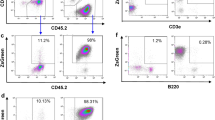Abstract
YAC is a Moloney-virus-induced lymphoma of strain A/Sn origin that is highly sensitive to natural killing (NK) in vitro and NK-mediated hybrid resistance in vivo. Previous studies have shown that hybrid resistance is under polygenic control that includes bothH-2-linked and non-H-2-linked factors. For further analysis on the genetics and immunology of hybrid resistance, we are at present developing congenic resistant lines on an A/Sn strain background. Following an outcross to a strain that conveys strong hybrid resistance on the F1 offspring, the mice are challenged with small viable inocula of YAC. Survivors are backcrossed to A/Sn. This is followed by repeated YAC challenge and backcrossing. We now report the successful establishment of a first resistant strain, designated A.LRA. It is relatively resistant to small inocula of YAC cells due to a single, non-H-2-linked dominant gene introduced from the C57L strain.
Similar content being viewed by others
References
Altman, P. L. and Katz, D.: Inbred and genetically defined strains of laboratory animals, Part I, Federation of American Societies for Experimental Biology, Bethesda, 1979
Åsjö, B., Kiessling, R., Klein, G., and Povey, S.: Genetic variation in antibody response and natural killer cell activity against a Moloney virus-induced lymphoma (YAC).Eur. J. Immunol. 8: 554–558, 1977
Åsjö, B., Fenyö, E. M., and Klein, G.: The role of humoral immunity and the contribution of the F1 antiparental effect in the rejection of a Moloney leukemia virus-induced lymphoma graft.Cancer Immunol. Immunotherapy, in press, 1983
Bishop, G. A. and Dove, W. F.: Semisyngeneic hybrid resistance to murine teratocarcinoma cells.Immunogenetics 10: 383–393, 1980
Cikes, M., Friberg, S., Jr., and Klein, G.: Progressive loss of H-2 antigens with concomitant increase of cell-surface antigen(s) determined by Moloney leukemia virus in cultured murine lymphomas.J. Natl. Cancer Inst. 50: 347–362, 1973
Doig, D. and Chesebro, B.: Anti-Friend virus antibody is associated with recovery from viremia and loss of viral leukemia cell-surface antigens in leukemic mice. Identification of Rfv-3 as a gene locus influencing antibody production.J. Exp. Med. 150: 10–19, 1979
Harmon, R. C., Clark, E. A., O'Toole, C., and Wicker, L. S.: Resistance of H-2 heterozygous mice to parental tumors. I. Hybrid resistance and natural cytotoxicity to EL-4 are controlled by the H-2D-Hh-1 region.Immunogenetics 4: 601–607, 1977
Kiessling, R., Petranyi, G., Klein, G., and Wigzell, H.: Genetic variation of in vitro cytolytic activity and in vivo rejection potential of non-immunized semisyngeneic mice against a mouse lymphoma line.Int. J. Cancer 15: 933–940, 1975
Kiessling, R., Petranyi, G., Klein, G., and Wigzell, H.: Non-T-cell resistance against a mouse Moloney lymphoma.Int. J. Cancer 17: 275–281, 1976
Klein, E. and Klein, G.: Antigenic properties of lymphomas induced by the Moloney agent.J. Natl. Cancer Inst. 32: 547–568, 1964
Klein, G., Klein, G. O., Kärre, K., and Kiessling, R.: “Hybrid resistance” against parental tumors: One or several genetic patterns?Immunogenetics 7: 391–404, 1978
Petranyi, G. G., Kiessling, R., Povey, S., Klein, G., Herzenberg, L., and Wigzell, H.: The genetic control of natural killer activity and its association with in vivo resistance against a Moloney lymphoma isograft.Immunogenetics 3: 15–28, 1976
Sato, H., Boyce, E. A., Aoki, T., Iritani, C., and Old. L. J.: Leukemia-associated transplantation antigens related to immune leukemia virus. The X.1 system: Immune response controlled by a locus linked to H-2.J. Exp. Med. 135: 593–606, 1973
Siegler, E. L., Tick, N., Tererty, A. K., Rogenstrauss, M., and Levine, A. J.: Teratocarcinoma transplantation rejection loci: An H-2 linked tumor rejection locus.Immunogenetics 9: 207–220, 1979
Snell, G. D.: Histocompatibility genes of the mouse. II. Production and analysis of isogenic resistant lines.J. Natl. Cancer Inst. 21: 843–877, 1958
Walker, M. C. and Philips-Quagliata, J. M.: Hybrid resistance to BALB/c plasmacytomas. I. Resistance to MPC-II controlled by a locus not linked to H-2.J. Immunol. 122: 1535–1547, 1979
Author information
Authors and Affiliations
Rights and permissions
About this article
Cite this article
Ährlund-Richter, L., Klein, G. & Klein, E. Genetic studies on natural resistance to Moloney lymphoma (YAC) isografts. I. Introduction of a non-H-2-linked resistance gene on strain A/Sn background. Immunogenetics 18, 221–227 (1983). https://doi.org/10.1007/BF00952961
Received:
Issue Date:
DOI: https://doi.org/10.1007/BF00952961




